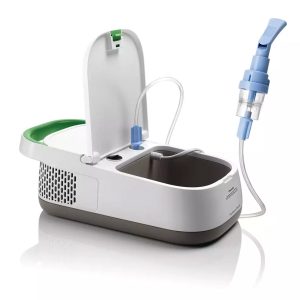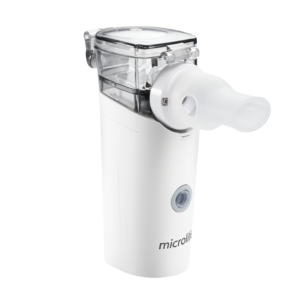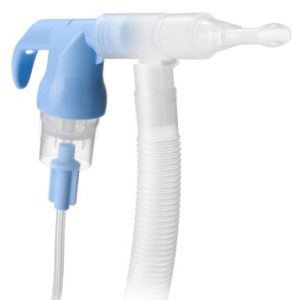Nebuliser Machines
What is a Nebuliser?
A nebuliser (or nebulizer for the US) is a device that delivers quick-acting medications, converting them from a liquid form to a fine mist that can be inhaled. These devices can administer a high dose of medication quickly and easily, helping to relax the airways and make breathing easier. They are, therefore, most associated with respiratory conditions such as asthma, COPD and emphysema, as they allow medicines to reach the lungs quickly and easily even if the patient’s breathing capacity is limited.
The medication is typically placed in a cup or chamber, and the device converts it into a fine mist using compressed air or ultrasonic vibration. The mist is then inhaled through a mask or mouthpiece.
They can be used as needed for symptom relief or as a regular part of a treatment plan to prevent symptoms from occurring. These devices can be helpful, particularly for people who have difficulty swallowing pills or using inhalers.
Our range of mains-powered and portable options are provided by world-leading manufacturers who design and develop medical equipment for healthcare facilities.
What are the different types of nebulisers for sale?
There are several different types, and these are detailed below.
Compressor Nebuliser (also called Jet or Nozzle)
This type uses a compressor to create airflow through the device and past the medicine, converting it into tiny particles that create a mist.
Jet Nebulisers often have more than one attachment available, allowing them to create different sizes of particles. This means they are compatible with almost commonly prescribed medications, making them a highly versatile choice.
They are also the most affordable option. Our most popular of these types is the Neb Pro 2-in-1 mains-operated machine. Another popular device is the Philips Innospire Go.
Mesh Nebuliser
Mesh devices are driven by a piezo-element and use ultrasonic frequencies to vibrate the mesh. The mesh vibrates and pulls the liquid through it, converting it into a mist.
Because the mesh is a fixed size, they are only suitable for certain medicines. The mesh is too fine for steroids, enzymes, or antibiotics to be used.
However, this type is usually handheld and battery-powered because the mesh method is so small, light and energy-efficient. This allows for it to be used almost anywhere.
They usually create the mist more quickly than a Jet nebuliser, reducing treatment times to under 5 minutes. Their portability and quick usage times have made them the go-to option for many. For this type of device, take a look at the Neb 800.
Ultrasonic Nebuliser
Ultrasonic nebulisers produce ultrasonic waves directly into the liquid medication, causing aerosol to be produced at the liquid surface. These devices generate high-frequency vibrations (2-3 million every second). These strong vibrations generate small particles from the liquid medication.
Like those made from Mesh, they cannot be used for all medications and are unsuitable for thicker medicines, such as antibiotics or steroids.
They also leave more residual medicine, meaning that less reaches your airway and goes to waste.
These limitations mean they are far less frequently used than the other options. We do not currently offer any Ultrasonic devices for these reasons.
Using a nebuliser
You should only use a device if all of the following apply:
- A healthcare professional has recommended one.
- A healthcare professional prescribes medications to use with it.
- The user (and carer) are trained to use it.
- The user (and carer) understands the risk of infection and knows how to clean and dry all the parts thoroughly to avoid infection.
You should only use the medication that has been prescribed for it.
These devices must be operated in a well-ventilated room with a window open and good airflow.
Why use a nebuliser instead of an inhaler?
An inhaler is a good way of getting regular small doses of reliever medications. When used with a spacer, they are 1/3 more effective at delivering the medication into the airway. Nebulisers can provide a much higher dose of medication and are more effective than an inhaler. Using a nebuliser for your asthma medication can be more effective.
Examples of when to use a nebuliser for asthma may include:
- In an emergency, if you struggle to breathe and need a high dose of your reliever medicine – paramedics or hospital staff may give you reliever medicine through a device.
- At home, if your condition is very severe and you cannot use an inhaler, inhalers are not as effective as nebulised medicine.
- If you can’t use an inhaler because of another health condition, such as arthritis.
- For lung conditions, especially those with COPD and asthma, using a handheld Inhaler is easier and just as effective, especially if used with a spacer. Still, if you live with certain lung conditions, like cystic fibrosis or bronchiectasis, your healthcare professional may arrange for you to use a nebuliser.
These devices can be a valuable tool in managing asthma, particularly for individuals with difficulty using inhalers or requiring rapid relief during asthma attacks. However, it’s essential to use them correctly and in accordance with your healthcare provider’s guidance to maximise effectiveness and safety.
For more information on nebulisers please visit our Nebulisers all you need to know advice page.
Nebulisers FAQs
Our nebuliser therapy machines are manufactured by Microlife, a market leader in the development and production of medical equipment.
Microlife creates and designs various equipment, including blood pressure monitors, asthma measuring devices, heat pads, and more. Their main focus is to enable people to monitor and improve their health, creating products free from environmentally harmful substances. All medical devices are safe to use and approved for hospital use.
Each device is designed with high-quality materials to improve and benefit people’s health at home.
Nebulisers are used for infants, small children and adults who require reliever medications and regular preventative, prescribed antibiotics. They are also good for people who suffer from lung conditions like:
- Asthma
- Bronchiectasis
- Chronic obstructive pulmonary disease (COPD)
- Cystic fibrosis
- Pulmonary fibrosis
The most appropriate device depends on your medication and the condition it is being used to treat.
Most nebulised treatments fall into two categories: upper airway treatment and lower airway treatment. Most devices will be designed primarily for lower airway treatments as this is the more common requirement of the two. These are typically reliever medicines.
Upper airway treatments are often medicines such as antibiotics. Most nebulisers can provide these types of medication but may need to be delivered via a mask rather than a mouthpiece or visa versa.
If you are unsure about your medication’s requirement, please do not ask us! We will be unable to advise you of this; this must be determined by your healthcare professional and is dependent on the prescribed medicine you require.
Several different medications can be nebulised and these include:
- Bronchodilators (relievers) – the drugs used to open up your airway and provide fast effective relief.
- Hypertonic saline solutions (medical grade saltwater solutions) – these loosen mucus in your airway and make it easier to cough up. We offer the SinuAir range with a high concentration of salt that can be used during nebulisation to help relieve wheezing and breathing discomfort.
- Antibiotics – are used to treat and prevent infections.
You should breathe through your mouth until all the medicine is used. When all the medicine is used, the mist will stop.
With a mains powered machine this takes around 10 to 15 minutes.
When using a device with small children it is sometimes easier to use a face mask, as they can sit comfortably until breathing has returned to normal.
These devices are not prescription items and can be purchased by anyone. You do not need to provide a prescription or any proof of requirement to purchase.
If you purchase a machine and discover you do not need it, we can only accept a return if the item is unopened and unused, and it has been returned to us within 30 days of placing your order.
Once opened, a machine cannot be returned as they are medical devices with hygiene restrictions. This applies even if the device hasn’t actually been used.
Therefore we strongly recommend that you only order a nebuliser if you have been prescribed a medicine that requires one.
If your device is not working, check the power source, and ensure it is plugged firmly into the power outlet. For portable devices, check the batteries to see if they need to be replaced or charged.
Here are a few things to check if your machine is not working:
- Check your accessories; tubing with kinks or a loose connection can prevent your device from working effectively.
- Ensure all of the parts, including the filter, are clean and do not need replacing.
Nebulised medications can reduce chest tightness, coughing, phlegm and other cold symptoms and they can effectively clear congestion and bacterial infections.
If your GP or healthcare provider has prescribed a liquid medication to relieve your cough, this may be suitable for nebulisation, but you will need to verify this with your GP before making a purchase.
No, these are both different types.
However, some devices including the portable NEB 800 use ultrasonic frequencies to vibrate the mesh.
No, you do not need to be 18, these devices can be purchased by anyone, but you may need a prescription from your doctor in order to purchase certain types of device.
Nebulisers can be purchased at 0% VAT (in other words, VAT free) under certain conditions.
Any product we sell that can have VAT relief claimed on it will have its price shown with 0% VAT as standard. This is because most of our customers qualify for VAT relief, and is therefore the price most customers will pay.
If you do not qualify then 20% VAT will be charged on top of the prices shown on the website.
If you order products that are eligible for VAT relief, then during the checkout process, you will have the option to declare yourself eligible for that relief. The process is very simple – you will see a VAT relief declaration, and a simple check box to confirm if this applies to you.
Who qualifies for VAT relief?
If you are buying a product that is eligible for VAT relief and the recipient of the eligible goods has a ‘chronic illness’ such as asthma or COPD and will be using the goods for their personal or domestic use, then VAT relief can be claimed. A simple tick declaration during the checkout is all that is required.
For clarity, if the recipient of the product will be using the device for reason other than treating a chronic illness, or will be using it in a non-domestic setting (ie in the workplace), or the purchase is being made or funded by a company, then VAT relief should not be claimed, and VAT will be charged at 20%.
The vast majority of our orders have VAT relief claimed because they meet the requirement explained above. If you are unsure of your eligibility, please contact us before you order and we will be happy to advise.
VAT relief is only available to UK customers.
For the Republic of Ireland, VAT must be applied at 21% on all deliveries to the Republic of Ireland.
For all other EU customers no VAT will be charged at the point of order, however, there may be tax on import.
Up until the declaration, the website will presume that VAT is to be charged at 20% (for example, at the Shopping Basket stage all orders will show 20% VAT being applied). Rest assured that this will be easily changed to 0% on eligible products during the checkout process, provided you declare that you qualify for relief.
Please see ‘Notice 701/7 VAT reliefs for disabled people’ on the GOV.uk website for full details.
There isn’t a list of officially approved devices from the NHS, although different clinics or prescribers may express a preference or recommendation for a particular brand, type or even a specific model.
Equally, there is no one brand, type or model used predominantly within NHS hospitals themselves. Each will acquire machines based on their own requirements, experience and preferences.
If you are looking for a nebuliser and are unsure which would be most suitable for you, then you should speak to your prescriber. They will know which type of device is most suitable for you and your medication.
Nebulisers are not typically provided by the NHS, even if you are prescribed medicine that requires one.
Some consultants or respiratory clinics may arrange for a device to be loaned to you, but this is not the norm. In most cases, the machine is to be purchased by the patient.




